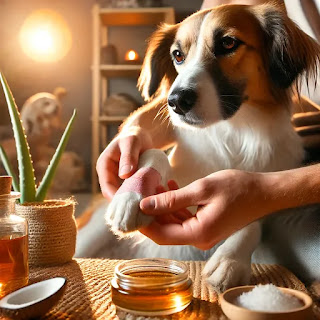As a dog owner, seeing your furry friend with an open wound can be alarming. Whether it’s a minor scrape from playtime or a small cut from an accident, prompt care is key to preventing infection and speeding up healing.
In this guide, we’ll cover safe, natural methods for dog wound treatment and dog cut care, including how to clean and manage an open wound on dog at home.
Step 1: Assess the Wound
Before treating your dog, evaluate the injury:
Minor wounds: Small cuts, scrapes, or shallow punctures.
Severe wounds: Deep cuts, heavy bleeding, or injuries near eyes/mouth.
Note: If the wound is severe, seek veterinary care immediately. For minor injuries, proceed with at-home care.
Step 2: Clean the Wound Properly
Learning how to clean a dog wound is critical to avoid infection:
Restrain your dog gently to prevent biting or movement. Use a muzzle if needed.
Trim fur around the wound with blunt scissors (to improve visibility).
Rinse with saline solution or lukewarm water to flush debris.
Disinfect using a vet-approved antiseptic (e.g., diluted betadine) or a natural option like chamomile tea (cooled and strained).
Pat dry with a clean cloth.
Avoid: Hydrogen peroxide or alcohol—these can damage tissue and delay healing.
Step 3: Natural Remedies to Speed Healing
For how to heal a dog wound fast at home naturally, try these safe options:
Aloe vera gel: Soothes skin and reduces inflammation (use 100% pure aloe).
Coconut oil: Antibacterial properties keep the wound moisturized.
Raw honey: A natural antimicrobial (apply a thin layer under a bandage).
Turmeric paste: Mix with water to create an antiseptic paste (prevents licking).
Tip: Prevent your dog from licking the wound with an Elizabethan collar or breathable bandage.
Step 4: Prevent Infection & Monitor Healing
Apply a vet-approved antibiotic ointment if the wound is at risk of infection.
Change bandages daily and watch for redness, swelling, or pus.
Boost immunity: Add omega-3 supplements or vitamin E to your dog’s diet for faster recovery.
Step 5: When to Visit the Vet
While minor wounds heal at home, consult a vet if you notice:
Persistent bleeding
Signs of infection (odor, heat, discolored discharge)
Lethargy or loss of appetite
Wounds that don’t improve within 48 hours
FAQs About Dog Wound Care
Q: Can I use human antiseptics on my dog?
A: Some (like diluted betadine) are safe, but avoid Neosporin unless approved by your vet.
Q: How do I stop my dog from scratching the wound?
A: Use a cone collar, soft bandage, or distraction techniques like interactive toys.
Q: What’s the fastest way to heal an open wound on a dog?
A: Keep it clean, apply natural remedies like honey or aloe, and prevent licking/scratching.
Final Tips
Stay calm—your dog will pick up on your stress.
Keep a dog first-aid kit stocked with gauze, saline, and natural antiseptics.
When in doubt, call your vet for guidance.
By following these steps for dog wound treatment, you’ll help your pup recover quickly and safely. Remember: Natural care works best for minor injuries, but professional help is irreplaceable for serious wounds.







